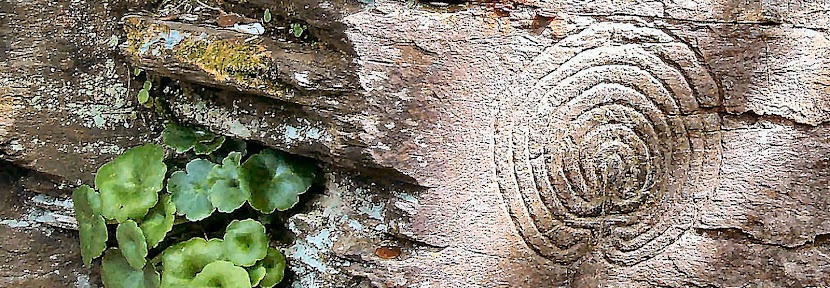I recently received correspondence from local author Ian Cooke about a scheme proposed by Natural England's HEATH project to fence off parts of the Penwith Moors in West Cornwall in readiness to graze cattle. In imminent danger is Nine Maidens Common. I visited the site today and here is my humble opinion on the sorry saga.
Save Nine Maidens Common
A report by Alex Langstone
A report by Alex Langstone
 Nine Maidens (Boskednan) Stone Circle
Nine Maidens (Boskednan) Stone CircleThe Land's End peninsula is world famous for its archaeology and beauty; and whilst it is, and should remain, a working landscape, we need to strike a balance between the needs to the land, the needs of farmers and the needs of tourism. The HEATH project is a well meant project, and in some areas cattle grazing is a good idea. But, cattle around ancient sites of significant cultural importance can create muddy quagmires on open moorland. Damage to the stones and the fabric of these ancient monuments can be substantial when cattle are allowed to graze amongst them. Erecting fences with points of access through gates, will create damage and erosion to the landscape by funnelling people into small areas of entry. Cattle also congregate at these entry points, which can only make the proble
 m worse. Nine maidens common does not need any grazing. I visited the site today, and it is well managed enough already. It is one of the most popular areas of open moorland in Penwith, with acess to such famous sites as the Men an Tol, Nine Maidens stone circle, Men Scryfa and Carn Galva. Plus loads of other bronze age barrows and standing stones, not well known, but equally important. Other areas such as Mulfra Common and Lanyon are also being considered for grazing. It is important to note that the Nine Maidens Common is a registered common, and as such, needs the permission of the Secretary of State for Environment before any changes can occur.
m worse. Nine maidens common does not need any grazing. I visited the site today, and it is well managed enough already. It is one of the most popular areas of open moorland in Penwith, with acess to such famous sites as the Men an Tol, Nine Maidens stone circle, Men Scryfa and Carn Galva. Plus loads of other bronze age barrows and standing stones, not well known, but equally important. Other areas such as Mulfra Common and Lanyon are also being considered for grazing. It is important to note that the Nine Maidens Common is a registered common, and as such, needs the permission of the Secretary of State for Environment before any changes can occur.Most importantly, Nine Maidens Common contains some of the finest and most interesting prehistoric sites in Southern Britain. Boskednan stone circle (marked on OS map as Nine Maidens, pictured above) is partly ruinous, but retains enough to be a dominating presence on the moor. When first viewed from the footpath, it stands out prominently almost on the top of the highest ridge. Eleven stones remain of the original twenty-two, one of which is remarkably tall for the stone circles of the region, standing at 2 metres. Other stones range from 1 to 1.3 metres in height. A slightly later round barrow touches the south side and can be clearly seen. About 40 metres north- north-west of the circle can be seen the remaining stump of an outlying menhir, and further to the north are the remains of three round barrows, one of which still has its large retaining stones, (pictured below) though the earthen mound has long since departed the scene! All in all this is a superb Bronze Age archaeological landscape, which needs to be protected and preserved.
In conclusion land management is vital to the conservation of our moors and heaths, but not by cattle grazing at the more sensitive archaeological sites please!
 A dedicated website has been set up by local author Ian Cooke, please visit and sign the petition, write to local MP, Andrew George, write to the Secretary of State for Environment, The Rt. Hon. Hilary Benn MP, and above all, tell people about this. It is vital we all have our viewpoint put forward before it is too late.
A dedicated website has been set up by local author Ian Cooke, please visit and sign the petition, write to local MP, Andrew George, write to the Secretary of State for Environment, The Rt. Hon. Hilary Benn MP, and above all, tell people about this. It is vital we all have our viewpoint put forward before it is too late.www.savepenwithmoors.com
You can also contact the HEATH project and visit their website www.theheathproject.org.uk
Point of contact; Joe Oliver, partnership manager.
Email: joe.oliver@naturalengland.org.uk.
Or write to: The HEATH Project, Natural England, Pydar House, Pydar Street, Truro, TR1 1XU, tel 01872 245045
Andrew George MP, Trewella, 18 Mayne Rd, Penzance TR18 4NG.
Secretary of State for the Environment. The Rt Hon Hilary Benn MP, Nobel House, 17 Smith Square, London SW1P 3JR
Remains of round barrow on Nine Maidens common pointing towards Carn Galva



